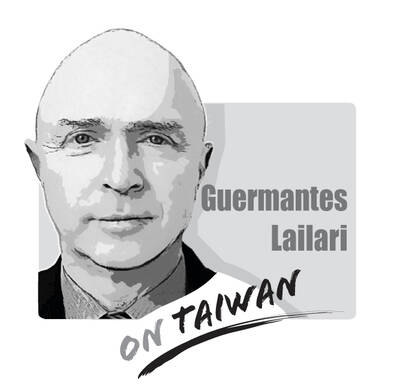On Thursday last week, China conducted large-scale military drills around Taiwan, jeopardizing peace and stability in the region. The air and maritime drills, formally named “Joint Sword-2024A,” came three days after President William Lai (賴清德) was sworn in.
The Chinese Communist Party’s (CCP) intentions behind these exercises are clear: to intimidate Taiwan and consolidate its geopolitical influence in the western Pacific.
The drills are also designed to send a message to key players in the region — namely the US and Japan — about China’s “inviolable sovereignty” and to discourage other countries from meddling in China’s “internal affairs.” The drills, and the potential dangers that accompany them, can be further analyzed from several perspectives.
First, the sheer scale of the exercises — involving multiple branches of the military from the Eastern Theater Command — emphasizes China’s determination to intimidate Taiwan militarily and warn Taiwanese independence forces against challenging the CCP’s “bottom line.”
The CCP seems to be adopting a “kill two birds with one stone” strategy: Beyond the obvious goal of tightening its grip on the Taiwan Strait, the CCP was using the opportunity to show off its strength and exert pressure on the US and Japan. This strategy might heighten the risk of conflict.
Second, the drills are a direct move to counter Taiwan’s pro-independence forces and joint combat exercises, highlighting an increased aggressiveness in the CCP’s stance toward Taiwan. China’s warning extends to all “outside forces,” and is a direct provocation to the US and Japan.
The CCP aims to assert its strategic influence in the region and challenge the US and Japan’s dominance in the western Pacific, a move likely to intensify regional geopolitical rivalries and increase the risk of military confrontation.
Thirdly, the pent-up tension in the region could create a vicious cycle further prompting the CCP to push for military action. If more drills such as “Joint Sword-2024B or C” were to be carried out, this would make the situation in the Taiwan Strait go from bad to worse.
Other countries in the region might feel compelled to affect their military expenditure in response. Rising military costs would not only impact economic and social development, but could also make conflict more likely, endangering global peace and stability.
The military drills put China’s ambition and wider intentions in plain view. By seeking to exert its influence on the regional landscape, China is turning the area into a geopolitical battleground.
In confronting the CCP military threat, nations should remain alert and bolster cooperation and coordination on security and defense matters. The international community should condemn the CCP’s military provocations and apply diplomatic and economic pressure to encourage a change in its attitude toward Taiwan. Rational dialogue and peaceful solutions are essential to reduce the risk of conflict, safeguard peace and promote development.
Chen Chun is an international affairs researcher.
Translated by Gabrielle Killick
Chinese actor Alan Yu (于朦朧) died after allegedly falling from a building in Beijing on Sept. 11. The actor’s mysterious death was tightly censored on Chinese social media, with discussions and doubts about the incident quickly erased. Even Hong Kong artist Daniel Chan’s (陳曉東) post questioning the truth about the case was automatically deleted, sparking concern among overseas Chinese-speaking communities about the dark culture and severe censorship in China’s entertainment industry. Yu had been under house arrest for days, and forced to drink with the rich and powerful before he died, reports said. He lost his life in this vicious
A recent trio of opinion articles in this newspaper reflects the growing anxiety surrounding Washington’s reported request for Taiwan to shift up to 50 percent of its semiconductor production abroad — a process likely to take 10 years, even under the most serious and coordinated effort. Simon H. Tang (湯先鈍) issued a sharp warning (“US trade threatens silicon shield,” Oct. 4, page 8), calling the move a threat to Taiwan’s “silicon shield,” which he argues deters aggression by making Taiwan indispensable. On the same day, Hsiao Hsi-huei (蕭錫惠) (“Responding to US semiconductor policy shift,” Oct. 4, page 8) focused on

George Santayana wrote: “Those who cannot remember the past are condemned to repeat it.” This article will help readers avoid repeating mistakes by examining four examples from the civil war between the Chinese Communist Party (CCP) forces and the Republic of China (ROC) forces that involved two city sieges and two island invasions. The city sieges compared are Changchun (May to October 1948) and Beiping (November 1948 to January 1949, renamed Beijing after its capture), and attempts to invade Kinmen (October 1949) and Hainan (April 1950). Comparing and contrasting these examples, we can learn how Taiwan may prevent a war with
In South Korea, the medical cosmetic industry is fiercely competitive and prices are low, attracting beauty enthusiasts from Taiwan. However, basic medical risks are often overlooked. While sharing a meal with friends recently, I heard one mention that his daughter would be going to South Korea for a cosmetic skincare procedure. I felt a twinge of unease at the time, but seeing as it was just a casual conversation among friends, I simply reminded him to prioritize safety. I never thought that, not long after, I would actually encounter a patient in my clinic with a similar situation. She had